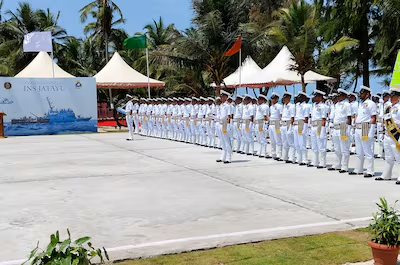India is bolstering its security infrastructure in the Indian Ocean to guard against Chinese efforts to expand its footprint in the region and upheaval in West Asia, a strategic expert said.
New Delhi has opened a new naval base at Minicoy, on its southernmost island of Lakshadweep, after the pro-China government in the Maldives ordered Indian troops to withdraw from its own territory – where India has 75 troops stationed – by March 10.
INS Jatayu will be India's second such base on the island after INS Dweeprakshak.
"This is part of a long-term plan to protect India's interests, specifically the 80 per cent of energy that is flowing through this region," Srikanth Kondapalli, a professor of Chinese Studies at New Delhi’s Jawaharlal Nehru University, told The National.
The Lakshadweep islands lie about 130km north of the Maldives.
Navy Chief Admiral R Hari Kumar said after the launch the new base was strategically important due to the “upsurge in maritime terror, crime and piracy” in the Indian Ocean.
“The Indian Navy has responded with an assertive posture in the west and north Arabian Sea, undertaking anti-drone, anti-missile and anti-piracy operations to safeguard merchant traffic in the region,” he said.
New Delhi had close security ties with the Maldives for decades but a regime change in the island nation last year and its increasing bond with China, India’s main regional rival, have soured relations.
A clutch of agreements was signed with Beijing during Maldives President Mohammad Muizzu's first overseas visit, to China, in January.
The Maldivian Defence Ministry this week said China would provide it with “military assistance” under a new agreement, which fosters “stronger bilateral ties".
The 75 Indian military personnel are deployed in the Maldives to maintain and operate an aircraft, which is on hand in the vulnerable low-lying islands for emergency evacuation purposes.

Experts say the launching of the naval asset is part of New Delhi’s long-term plan to secure its economic and geopolitical interests, as well as to strengthen its military presence in the region.
The Arabian Sea is part of the Indian Ocean region that comprises about 20 per cent of the world's ocean area and connects the shores of three continents.
About 40 per cent of the world’s offshore oil production takes place in the Indian Ocean basin and approximately 80 per cent of the world’s maritime oil trade passes through, the US think tank Hudson Institute estimates.
“We import $180 billion worth of energy and if we are growing at 6 to 7 per cent growth rate, then we need to import more energy and much of this is next door – West Asia,” Prof Kondapalli said. "The Indian Ocean becomes crucial."
New Delhi is also wary of Beijing's growing infrastructure and military assets across several countries that strategically surround India – from the Himalayas to the Indian Ocean.
China has a major say in Hambantota Port in Sri Lanka, the commercial activities of which were handed over to Beijing in 2017 on a 99-year lease after Colombo failed to pay off mounting debts.
Beijing has recently invested billions of dollars in infrastructure projects in Pakistan, including in the key deep-sea port of Gwadar, as well as in the Maldives, Myanmar, Bangladesh and Nepal.
New Delhi has been increasing military spending since Prime Minister Narendra Modi came to power in 2014 and has built naval bases in the Bay of Bengal.
“The Chinese have the intention to counter India because it has become the largest trading partner for all the Indian Ocean states," Prof Kondapalli said. “India's assessment is that China is becoming a major power centre in the Indian Ocean. The Indian Navy thinks China is going to be a long-term challenge.”
The emergence of piracy and maritime terrorism along with the presence of Pakistan, India’s arch-rival, in the Arabian Sea is another perceived threat in the region for Mr Modi's government.
While India is not a member of the US-led Operation Prosperity Guardian to counter Houthi attacks in the Red Sea, its navy has responded to an increase in attempted hijacking attacks launched by pirates and the Iran-backed Yemeni militants.
“[The] Arabian Sea is crucial because of the Pakistan factors, because of the Houthis and the Persian Gulf region," Prof Kondapalli said. "The Arabian Sea is a link to the Red Sea, the Persian Gulf and the passageway into the Indian Ocean."
In the event of any escalation between the US and Iran, he said Tehran would have a plan to block any traffic in the Arabian Sea.
“We have not seen the US-Iran conflict emerging in any coherent manner yet,” he said. "That is a contingency the Iranians have to blockade the Persian Gulf, because $120 billion of oil passes through Persian Gulf. They would like to inflict damage in this area."





